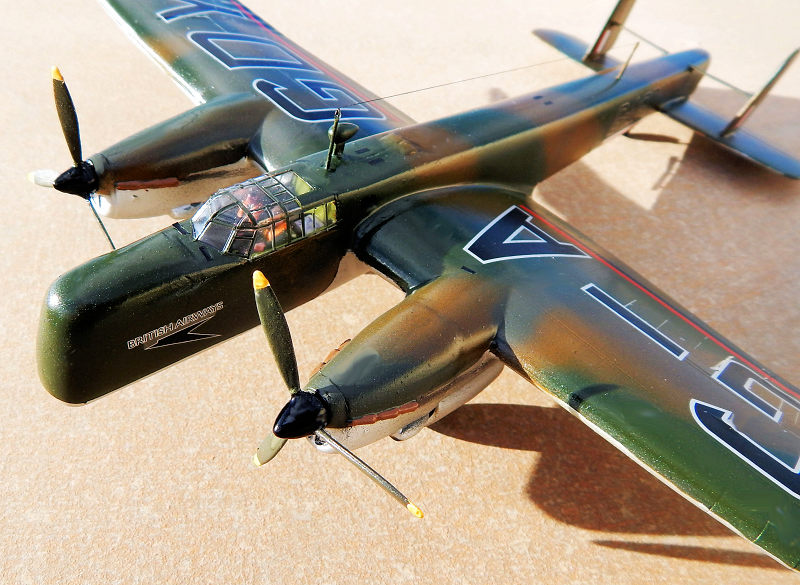
Frog 1/72 Whitley V freighter
| KIT #: | F-207 |
| PRICE: | 5 Euros |
| DECALS: | Two Options |
| REVIEWER: | Carmel J. Attard |
| NOTES: | Kit bash |

| HISTORY |
The full story of the Whitley‘s contribution to Bomber Command offensive is beyond the scope of this short history. The Whitley was used in a variety of roles in its various marks. The Whitley Mk V in particular was released from Bomber Command in April 1942, last operation being flown against Ostend during the night of 29 April, although some aircraft from Operational Training Unit were flown in the 1,000-bomber raid on Koln in the night of 30th May 1942.
Coastal Command association with the Whitley began in September 1939 when No 58 Squadron was transferred to Boscombe Down to operate anti-submarine patrols over the English Channel. Whitleys were also used by No 1 Parachute Training School and were used in glider tugs becoming attached to No21 Glider Conversion Unit at Brize Norton for training of tug pilots. Other numerous sorties included dropping agents into occupied territory and supplying resistance groups with arms and equipment.
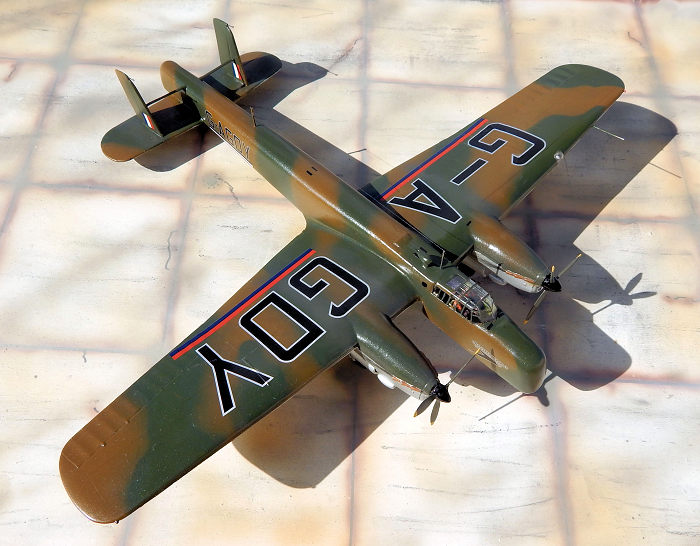 Mid 1942 saw a new type of
Whitley take to the air---- the Mk V freighter. Fifteen of the types were
converted for freighter duties with B.O.A.C. in the spring of 1942. All (but
one casualty) were returned to the RAF by 1943. This mark was a conversion
for use in the civil routes of B.O.A.C. No turrets or armament were fitted.
The recesses were faired-in with stressed, light alloy pressings; these
contained small rectangular Perspex panels and were identical to those
fairings fitted to early Whitleys. Extra fuel tanks were carried in the bomb
bays and room was made in the fuselage for the stowage of freight.. Other
equipment included extra radio equipment, batteries and a rubber dinghy. One
machine had the entrance door enlarged. All the modifications were made by
the Technical Department of B.O.A.C.. The machines were finished in standard
B.O.A.C. wartime paint scheme and carried their civil registration in black
outlined in silver above a red, white and blue stripe on fuselage sides and
beneath the wings. Performance, including top speed and loaded weight, were
approximately the same as for standard Mk V bomber.
Mid 1942 saw a new type of
Whitley take to the air---- the Mk V freighter. Fifteen of the types were
converted for freighter duties with B.O.A.C. in the spring of 1942. All (but
one casualty) were returned to the RAF by 1943. This mark was a conversion
for use in the civil routes of B.O.A.C. No turrets or armament were fitted.
The recesses were faired-in with stressed, light alloy pressings; these
contained small rectangular Perspex panels and were identical to those
fairings fitted to early Whitleys. Extra fuel tanks were carried in the bomb
bays and room was made in the fuselage for the stowage of freight.. Other
equipment included extra radio equipment, batteries and a rubber dinghy. One
machine had the entrance door enlarged. All the modifications were made by
the Technical Department of B.O.A.C.. The machines were finished in standard
B.O.A.C. wartime paint scheme and carried their civil registration in black
outlined in silver above a red, white and blue stripe on fuselage sides and
beneath the wings. Performance, including top speed and loaded weight, were
approximately the same as for standard Mk V bomber.
The introduction of Whitley
freighters on to B.O.A.C. routes was an expedient of necessity as they were
unsuited for the work. They were expected to carry loads of much greater
volume than before and furthermore, to do so through climates ranging from
warm to tropical. They were first tried out on the U.K.-West Africa run, but
their engines overheated so alarmingly that the experiment was discontinued.
A small fleet of them was then dispatched to Gibraltar to fly essential
freight into b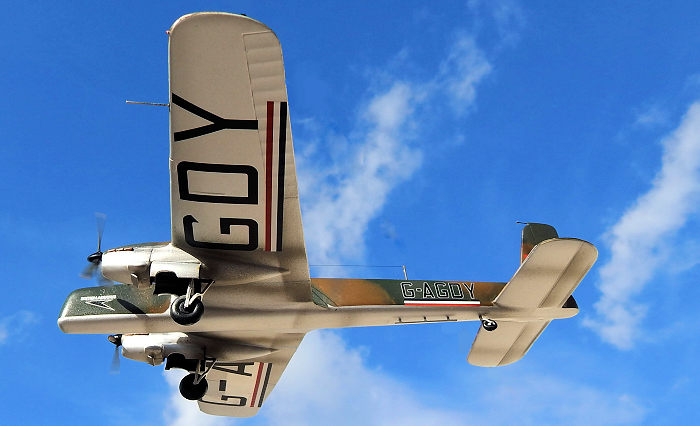 eleaguered Malta by night—a nightmarish journey of seven
hours. They were flown at over-load and their captains knew that, thus
laden, they could not possibly fly on one engine. Engine failure meant
dropping like a brick into the sea, and since overheating was often suffered
in the warm climate of the Mediterranean summer, an engine failure was well
on the cards.
eleaguered Malta by night—a nightmarish journey of seven
hours. They were flown at over-load and their captains knew that, thus
laden, they could not possibly fly on one engine. Engine failure meant
dropping like a brick into the sea, and since overheating was often suffered
in the warm climate of the Mediterranean summer, an engine failure was well
on the cards.
Nevertheless the Whitley freighters were worked to capacity, as many as six arriving, often in the middle of a heavy “blitz” with supplies to Malta in one night. Apart from the risk of engine failure, however, they proved uneconomical to operate and in August 1942 the much roomer Hudsons replaced them. The following year the Whitleys were tried out in the U.K. Leuchars- Sweden, Stockholm route but were unsuccessful.
The fifteen Whitley Vs converted into freighters for B.O.A.C in 1942 were: BD360-BD365 inclusive (registered G-AGCF-‘CK inclusive), BD382-BD390 inclusive (registered G-AGDU-‘DZ inclusive, and G-AGEA-‘EC inclusive)
| THE KIT |
Making use of extra parts found in the Airfix kit to modify and improve the old Frog kit.
The recent release of the Airfix
re-tooled Whitley kit can be built into either a Maritime bomber or a transport
version. This means that if the kit is made as a Maritime version there are then
the extra parts to produce the transport version, an opportunity for me to build
another type with Maltese
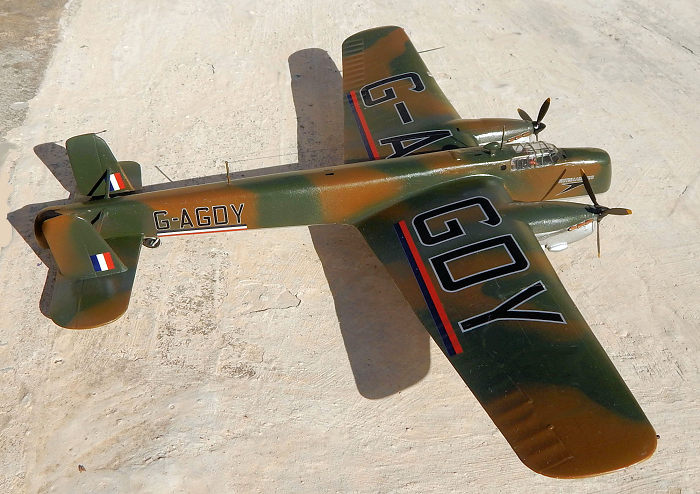 connection considering its service history. This is
also a chance to utilize an old Frog kit I had in my stash for many years, into
the transport version with authentic decals for the type
connection considering its service history. This is
also a chance to utilize an old Frog kit I had in my stash for many years, into
the transport version with authentic decals for the type
At first glance the Frog kit seems quite good, with very delicate raised detail and straightforward parts breakdown. However the Merlin engine cowls and radiators are a bit too tapered in appearance, the clear parts are too heavily framed, and too simplistic in the case of the turrets. Closer checks also revealed the rear fuselage to be too narrow in plan view as also is the forward fuselage, the upper-side of the ailerons to be on the large side, and the chin below the front turret to be wrong. So the occasion arose to improve on the kit with minimum effort.
Besides making good use of the alternative and excellent decal sheet that comes with the Airfix kit there are the other parts, basically the nose and aft fairings and the clear canopy without the astrodome, all of which came now very handy. The Frog kit of the Mk V has 68 parts moulded in white styrene. I went by the 9-stage instructions, painting the interiors of cockpit as I went along the kit build. All parts associated with the nose and tail turrets as well as clear parts were all of no use and are left out.
| CONSTRUCTION |
In order to match the Airfix
parts I had to widen the fuselage by around 1/8 inch. This was adjusted by
fitting a plastic card insert in between the forward fuselage halves to bring
desired width. Areas to be removed were marked with reference to the Airfix
model and now the Frog kit is cut using Exacto saw
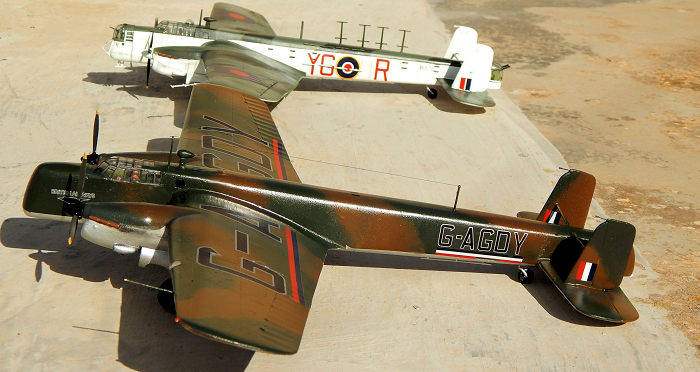 blade removing the nose and
aft turret compartments. The new blanking pieces were then glued in place.
Little filler if any was added. I also replaced the old Frog undercarriage parts
mainly the legs and supports with a more accurate and robust metal set 72115
issued by SAC with no difficulty. A piece of Perspex with light engraved in it
was also added to the port wing leading edge.
blade removing the nose and
aft turret compartments. The new blanking pieces were then glued in place.
Little filler if any was added. I also replaced the old Frog undercarriage parts
mainly the legs and supports with a more accurate and robust metal set 72115
issued by SAC with no difficulty. A piece of Perspex with light engraved in it
was also added to the port wing leading edge.
| COLORS & MARKINGS |
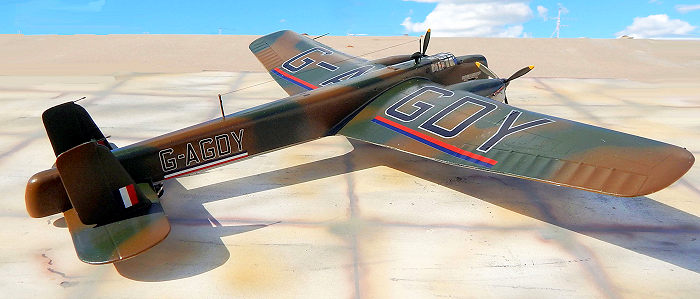 After the kit was sanded smooth
and made sure no blemishes remain at the modified areas I fitted the crystal
clear Airfix canopy in place. The kit was sprayed in dark earth and dark green
wartime camouflage on upper surfaces and silver undersides where proper masking
taking much of the time for this procedure. Kit was then given an overall coat
of Future. The Airfix decals now came handy for this version, applying the
undersides decals large registration letters G-AGDY first along with the three
colour B.O.A.C. stripes.. The top surface decals followed. The model was in the
end sealed with a coat of Alclad satin lacquer overall.
After the kit was sanded smooth
and made sure no blemishes remain at the modified areas I fitted the crystal
clear Airfix canopy in place. The kit was sprayed in dark earth and dark green
wartime camouflage on upper surfaces and silver undersides where proper masking
taking much of the time for this procedure. Kit was then given an overall coat
of Future. The Airfix decals now came handy for this version, applying the
undersides decals large registration letters G-AGDY first along with the three
colour B.O.A.C. stripes.. The top surface decals followed. The model was in the
end sealed with a coat of Alclad satin lacquer overall.
| CONCLUSIONS |
This minor conversion looked like a quantum leap over the vintage straight OOB Frog kit build in view of the accurate items added complete with a state of the art decal sheet. I am happy with the hours spent on it and the Whitley transport will join another type a DH Rapide that was likewise finished in B.O.A.C. wartime livery.
Carmel J. Attard
12 January 2018 Copyright ModelingMadness.com If you would like your product reviewed fairly and fairly quickly, please contact the editor or see other details in the
Note to
Contributors. Back to the Main Page
Back to the Review
Index Page
Back to the Previews Index Page